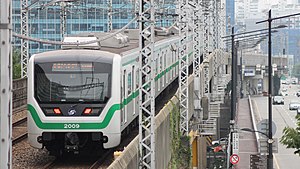This article has multiple issues. Please help improve it or discuss these issues on the talk page. (Learn how and when to remove these messages)
|
| Seoul Metropolitan Subway | |||
|---|---|---|---|
 Seoul Metro 2000 series train on Line 2 | |||
| Overview | |||
| Native name | 수도권 전철 / 首都圈電鐵 Romanizations see box below | ||
| Owner | Government of South Korea, Seoul Metropolitan Government, Incheon Metropolitan City, Bucheon City, Uijeongbu City, Yongin City | ||
| Locale | Seoul Capital Area | ||
| Transit type | Rapid transit, Commuter rail | ||
| Number of lines | 23 | ||
| Number of stations | 768 | ||
| Annual ridership | 1.91 billion (2017, Lines 1-9, Seoul Subway)[1] 1.16 billion (2017, Korail)[2] | ||
| Operation | |||
| Began operation | 15 August 1974 | ||
| Operator(s) | Seoul Metro, Korail, Incheon Transit Corporation, and private rapid transit operators | ||
| Technical | |||
| System length | 1,302.2 km (809.1 mi) (all lines) | ||
| Track gauge | 1,435 mm (4 ft 8+1⁄2 in) standard gauge | ||
| |||
| Seoul Metropolitan Subway | |
| Hangul | |
|---|---|
| Hanja | |
| Revised Romanization | Sudogwon Jeoncheol |
| McCune–Reischauer | Sudokwŏn Chŏnch'ŏl |
The Seoul Metropolitan Subway (Korean: 수도권 전철) is a metropolitan railway system consisting of 23 rapid transit, light metro, commuter rail and people mover lines located in northwest South Korea. The system serves most of the Seoul Metropolitan Area including the Incheon metropolis and satellite cities in Gyeonggi province. Some regional lines in the network stretch out beyond the Seoul Metropolitan Area to rural areas in northern Chungnam province and western Gangwon Province, that lie over 100 km (62 mi) away from the capital.[3]
The network consists of multiple systems that form a larger, coherent system. These being the Seoul Metro proper, consisting of Seoul Metro lines 1 through 9 and certain light rail lines, that serves Seoul city proper and its surroundings; Korail regional rail lines, which serve the greater metropolitan region and beyond; Incheon Metro lines, operated by Incheon Transit Corporation, that serve Incheon city proper; and miscellaneous light rail lines, such as Gimpo Goldline and Yongin Everline, that connect lower-density areas of their respective cities to the rest of the network.[4] Most of the system is operated by three companies – Seoul Metro, Korail (Korea Railroad Corporation), and Incheon Metro – with the rest being operated by an assortment of local municipal corporations and private rail companies.
Its first metro line, Line 1, started construction in 1971 and began operations in 1974, with through-operation to Korail's suburban railways. As of 2022, the network has 331.5 km (206.0 mi) of track on lines 1–9 alone.
Most of the trains were built by Hyundai Rotem, South Korea's leading train manufacturer.
- ^ "자료실 : 알림마당>자료실>자료실". www.seoulmetro.co.kr.
- ^ 수송현황 - 통계 - 량 [Transportation status - statistics - volume]. Korail (in Korean). Archived from the original on 14 November 2021.
- ^ 2012 Korail Statistics See p.400 for Seoul Metropolitan Subway (수도권 전철). Archived 27 February 2014 at the Wayback Machine
- ^ "Ministry of Land, Transport and Maritime Affairs of South Korea: Definition of Urban Rail and Wide-area Rail". Archived from the original on 25 April 2012.
